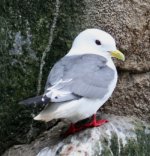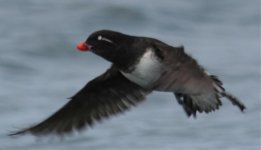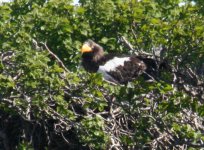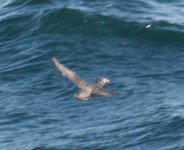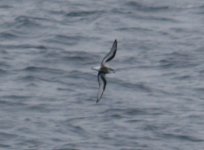AStevenson
Well-known member
I luckily managed to get on a cruise on a late availability cheap deal in July, could never have afforded it otherwise. Even getting there is an experience - 9 hour internal flight from Moscow to Petropavlovsk (only city in Kamchatka).
Petropavlovsk must be the only city in the world to have 3 'domestic' volcanoes!! It was drizzly when we arrived on 9 July, but during the day it dried up and the wind got up which made it hard to pick up passerines whilst having a short city tour by bus - however, we did pick up tree sparrow (replaces house sparrow in the far east), Arctic warbler and common rosefinch, whilst in the harbour where our ship were slaty-backed and glaucous-winged gulls, black-legged kittiwake, a few common guillemots, pelagic cormorants and the first class bird of the trip - tufted puffins.
Unfortunately, the wind was forecast to continue and our cruise start was posponed for a day. As an alternative the company organised some sight seeing trips inland of Petropavlovsk on the 10th - visiting a reconstruction of an Ittelman (local native people) village where a dance troupe performed (their culture and traditional dress is not unsurprisingly similar to Pacific NW native American tribes), and a husky racing centre.
Interesting as they were, for those of us more interested in birds, these trips provided an opportunity to travel through varied countryside and visit some woodland and marshland areas. A few good birds were picked up rough-legged buzzards and black-billed (longipennis) common terns in the open and wetland areas, whilst the woodland provided an unsual mix of birds, the more familiar willow tits and grey wagtails, mixing with the very common Arctic warbler, yellow-breasted bunting, rustic bunting, Oriental cuckoo, family parties of olive-backed pipit and best of all some cracking Siberian rubythroats. The weather being much better than the previous day we returned to the ship ready to leave in the evening, not before we logged Pacific swifts hawking over the Petropavlovsk. The evening sail brough us a few Ancient murrelets and Dall's porpoise before dusk.
The 11th dawned cold and misty with low cloud obscuring the tops of the still partly snow-clad mountains as we sailed up a sealoch. Two large very distant 'rocks' on the beach looked 'suspicious' - one eventually took flight revealing it to be our first Steller's sea eagle (!). In the dull light several birds on the water eventually resolved themselves as a mix of harlequin ducks, pigeon guillemots and a long-billed murrelet(!). A trip ashore and around the bay in zodiacs (inflatable boats) revealed buff-bellied pipits on the shore along with black-backed wagtail, more harlequin ducks, and better views of the same Steller's sea eagles seen earlier, and our first Kamchatka bear (full marks to the Russian girl on the boat who spotted it high on a hillside without binoculars putting us to shame!!).
After a breathtaking trip up the stunning coastline in the sunshine, the next stop on the 11th was the Zhupanova river mouth where there was wide selection of gulls including Kamchatka (common/Mew) gulls, Arctic skua, and in the marshes reed bunting and yellow wagtail of the attractive simillima/tschutschensis subsp. Oh and the highlight here being a zodiac trip (keeping a respectable distance) to an active Steller's sea eagle nest - the sitting bird was absolutely massive!!!
In the evening we set sail for the Commander Islands (Bering & Medny islands) the Russian end of the Aleutians, partly to make up time having lost a day, which meant the 12th being a full day at sea. The weather was good being pretty calm with the light conditions good for spotting seabirds and cetaceans. All day seawatching from the deck allowed us to pick up several whale species (Fin, Sei, Sperm and commonest of all Humpback, of which several groups were very close to the ship) and lots of Dall's porpoises. Seabirds included lots of short-tailed and sooty shearwaters (and good for ID tests!), Laysan albatross, mottled petrels and fork-tailed (a superb bird) and Leach's petrels. A few pomarine and Arctic skuas provided further interests as did our first red-legged kittiwakes(!). Auks at sea provided tufted puffins (common), horned puffin (scarce), common and Brunnich's guillemots, and some of the North Pacific auklet specialities - crested, least and parakeet (!!). Most surprising were the redpoll which landed on board and the grey wagtail which flew past!!!
The evening of the 12th saw us cruising round Ari Kamen a small rock covered in seabirds - close up views of many of the seabirds mentioned above but also colonies of pelagic and red-faced cormorants.
The 13th saw us heading ashore at Bering Island, first stop at the north west end was to visit a large Northern Fur-seal colony which also had some Steller's Sea-lions, with groups of sea otters lounging offshore. In the seal colony were one or two Arctic foxes scavenging, along with the gulls. The coastal vegetation was sand dune like and very lush with many orchids and long grasses - passerines here were snow and Lapland buntings, along with the strange parachuting displayflights and buzzing song of Pechora pipits.
In the afternoon, the only village on Bering Island Nikolskoye was visited to see some Aleutian native culture, however, the philistine birders, headed off to the river mouth by the village. Rock sandpipers were on the shore here, and amongst the loafing glaucous-winged gulls were a few glaucous, whilst on the river were dunlin (sakhalina race), and a couple of superb Mongolian plovers. The the fields and marches produced little except loads of Lapland buntings although a vagrant Oriental greenfinch was singing and a fw tree sparrows were seen in the village.
Overnight we moved round to Medny island for the 14th, and took zodiac cruises round some seabird colonies - excellent views of sea otters on the water, and our first grey-crowned rosy-finches on the cliffs. The volcanic rock scenery is similar to Skye or St Kilda, but on steroids! All the time we were accompanied by hoards of northern fulmars, nearly all the dark brownish morph. Also some close views of crested and parakeet auklets on the water. With the weather improving we made another two stops getting some excellent views of seabirds and larga seals, as well as the Aleutian subsp. of winter wren (very like the St Kilda wren).
On the 15th we headed back to Bering Island sailing through some large groups of feeding auklets, adding whiskered to the list, and shearwaters. A visit was made to a bay with a large red-legged kittiwake colony with excellent photo opportunities, pigeon guillemot and harlequin ducks provide further distraction as did a minke whale feding in the bay. In the afternoon we visited Commander Bay where the explorer Bering was shipwrecked and subsequently died - a rather bleak and remote spot!, however exploration of the tundra inland revealed a family party of Mongolian plovers.
Overnight we headed back to the Kamchatka coast but evening seawatching provides a few more Laysan albatross, mottled petrels, lots of fork-tailed petrels , an out of place Wilson's petrel, and auklets. Early morning of the 16th saw us anchoring in Kamenistaya bay on the Kamchatka coast on a grey day. A few murrelets present in the bay included both Kittlitz and long-billed. Other goodies included red-necked grebe and a white-billed diver, however the main target for the cruise staff was locating bears. Fresh footprints on the beach looked promising if a little scary given the size of them! However, our initial walk round the bay and into the scrubby woodland failed to prodce bears, although lots of mosquitoes! We did though see a couple of rather damp swallowtail butterflies and passerine birds included common redpolls and Middendorf's grasshopper warbler - a great tick if only for the name!!
As we returned to the ship a bear was spotted well to the south of the bay, which when watched through the scope back on board showed to be a mother with cubs. After lunch a flotilla of zodiacs carefully made their way across the bay to where the bears were, and although they retreated into the grass a bit, good views were obtained along with a few photos.
Then followed a cruise down the coast towards our next stop, again this was excellent for seabirds (lots of auklets and murrelets, huge numbers of both red-necked and red/grey phalaropes, and a couple of long-tailed skuas) and cetaceans with a group of 10 or so Orcas close to the boat.
The 17th was our last day and we found ourselves heading into some big sealochs early morning when we managed another sperm whale and a few more long-billed murrelets. No sooner than we'd anchored did we realise we were in an area with several more Steller's sea eagle territories - with an immature flying right over us being mobbed by a small crow which was actually a raven! Landbirds ashore wer similar to the previous day although some good views of Siberian rubythroat, Middendorf's GW, and I almost trod on a lanceolated warbler. In the afternoon we visited a haul out of Steller's sea-lions where the local pod of Orcas was in residence as we arrived which rounded off our cruise in style. Overnight we headed back to Petropavlovsk for our lunchtime flight.
A truly fantastic trip which I've still not recovered from!
Cheers,
Andrew
Petropavlovsk must be the only city in the world to have 3 'domestic' volcanoes!! It was drizzly when we arrived on 9 July, but during the day it dried up and the wind got up which made it hard to pick up passerines whilst having a short city tour by bus - however, we did pick up tree sparrow (replaces house sparrow in the far east), Arctic warbler and common rosefinch, whilst in the harbour where our ship were slaty-backed and glaucous-winged gulls, black-legged kittiwake, a few common guillemots, pelagic cormorants and the first class bird of the trip - tufted puffins.
Unfortunately, the wind was forecast to continue and our cruise start was posponed for a day. As an alternative the company organised some sight seeing trips inland of Petropavlovsk on the 10th - visiting a reconstruction of an Ittelman (local native people) village where a dance troupe performed (their culture and traditional dress is not unsurprisingly similar to Pacific NW native American tribes), and a husky racing centre.
Interesting as they were, for those of us more interested in birds, these trips provided an opportunity to travel through varied countryside and visit some woodland and marshland areas. A few good birds were picked up rough-legged buzzards and black-billed (longipennis) common terns in the open and wetland areas, whilst the woodland provided an unsual mix of birds, the more familiar willow tits and grey wagtails, mixing with the very common Arctic warbler, yellow-breasted bunting, rustic bunting, Oriental cuckoo, family parties of olive-backed pipit and best of all some cracking Siberian rubythroats. The weather being much better than the previous day we returned to the ship ready to leave in the evening, not before we logged Pacific swifts hawking over the Petropavlovsk. The evening sail brough us a few Ancient murrelets and Dall's porpoise before dusk.
The 11th dawned cold and misty with low cloud obscuring the tops of the still partly snow-clad mountains as we sailed up a sealoch. Two large very distant 'rocks' on the beach looked 'suspicious' - one eventually took flight revealing it to be our first Steller's sea eagle (!). In the dull light several birds on the water eventually resolved themselves as a mix of harlequin ducks, pigeon guillemots and a long-billed murrelet(!). A trip ashore and around the bay in zodiacs (inflatable boats) revealed buff-bellied pipits on the shore along with black-backed wagtail, more harlequin ducks, and better views of the same Steller's sea eagles seen earlier, and our first Kamchatka bear (full marks to the Russian girl on the boat who spotted it high on a hillside without binoculars putting us to shame!!).
After a breathtaking trip up the stunning coastline in the sunshine, the next stop on the 11th was the Zhupanova river mouth where there was wide selection of gulls including Kamchatka (common/Mew) gulls, Arctic skua, and in the marshes reed bunting and yellow wagtail of the attractive simillima/tschutschensis subsp. Oh and the highlight here being a zodiac trip (keeping a respectable distance) to an active Steller's sea eagle nest - the sitting bird was absolutely massive!!!
In the evening we set sail for the Commander Islands (Bering & Medny islands) the Russian end of the Aleutians, partly to make up time having lost a day, which meant the 12th being a full day at sea. The weather was good being pretty calm with the light conditions good for spotting seabirds and cetaceans. All day seawatching from the deck allowed us to pick up several whale species (Fin, Sei, Sperm and commonest of all Humpback, of which several groups were very close to the ship) and lots of Dall's porpoises. Seabirds included lots of short-tailed and sooty shearwaters (and good for ID tests!), Laysan albatross, mottled petrels and fork-tailed (a superb bird) and Leach's petrels. A few pomarine and Arctic skuas provided further interests as did our first red-legged kittiwakes(!). Auks at sea provided tufted puffins (common), horned puffin (scarce), common and Brunnich's guillemots, and some of the North Pacific auklet specialities - crested, least and parakeet (!!). Most surprising were the redpoll which landed on board and the grey wagtail which flew past!!!
The evening of the 12th saw us cruising round Ari Kamen a small rock covered in seabirds - close up views of many of the seabirds mentioned above but also colonies of pelagic and red-faced cormorants.
The 13th saw us heading ashore at Bering Island, first stop at the north west end was to visit a large Northern Fur-seal colony which also had some Steller's Sea-lions, with groups of sea otters lounging offshore. In the seal colony were one or two Arctic foxes scavenging, along with the gulls. The coastal vegetation was sand dune like and very lush with many orchids and long grasses - passerines here were snow and Lapland buntings, along with the strange parachuting displayflights and buzzing song of Pechora pipits.
In the afternoon, the only village on Bering Island Nikolskoye was visited to see some Aleutian native culture, however, the philistine birders, headed off to the river mouth by the village. Rock sandpipers were on the shore here, and amongst the loafing glaucous-winged gulls were a few glaucous, whilst on the river were dunlin (sakhalina race), and a couple of superb Mongolian plovers. The the fields and marches produced little except loads of Lapland buntings although a vagrant Oriental greenfinch was singing and a fw tree sparrows were seen in the village.
Overnight we moved round to Medny island for the 14th, and took zodiac cruises round some seabird colonies - excellent views of sea otters on the water, and our first grey-crowned rosy-finches on the cliffs. The volcanic rock scenery is similar to Skye or St Kilda, but on steroids! All the time we were accompanied by hoards of northern fulmars, nearly all the dark brownish morph. Also some close views of crested and parakeet auklets on the water. With the weather improving we made another two stops getting some excellent views of seabirds and larga seals, as well as the Aleutian subsp. of winter wren (very like the St Kilda wren).
On the 15th we headed back to Bering Island sailing through some large groups of feeding auklets, adding whiskered to the list, and shearwaters. A visit was made to a bay with a large red-legged kittiwake colony with excellent photo opportunities, pigeon guillemot and harlequin ducks provide further distraction as did a minke whale feding in the bay. In the afternoon we visited Commander Bay where the explorer Bering was shipwrecked and subsequently died - a rather bleak and remote spot!, however exploration of the tundra inland revealed a family party of Mongolian plovers.
Overnight we headed back to the Kamchatka coast but evening seawatching provides a few more Laysan albatross, mottled petrels, lots of fork-tailed petrels , an out of place Wilson's petrel, and auklets. Early morning of the 16th saw us anchoring in Kamenistaya bay on the Kamchatka coast on a grey day. A few murrelets present in the bay included both Kittlitz and long-billed. Other goodies included red-necked grebe and a white-billed diver, however the main target for the cruise staff was locating bears. Fresh footprints on the beach looked promising if a little scary given the size of them! However, our initial walk round the bay and into the scrubby woodland failed to prodce bears, although lots of mosquitoes! We did though see a couple of rather damp swallowtail butterflies and passerine birds included common redpolls and Middendorf's grasshopper warbler - a great tick if only for the name!!
As we returned to the ship a bear was spotted well to the south of the bay, which when watched through the scope back on board showed to be a mother with cubs. After lunch a flotilla of zodiacs carefully made their way across the bay to where the bears were, and although they retreated into the grass a bit, good views were obtained along with a few photos.
Then followed a cruise down the coast towards our next stop, again this was excellent for seabirds (lots of auklets and murrelets, huge numbers of both red-necked and red/grey phalaropes, and a couple of long-tailed skuas) and cetaceans with a group of 10 or so Orcas close to the boat.
The 17th was our last day and we found ourselves heading into some big sealochs early morning when we managed another sperm whale and a few more long-billed murrelets. No sooner than we'd anchored did we realise we were in an area with several more Steller's sea eagle territories - with an immature flying right over us being mobbed by a small crow which was actually a raven! Landbirds ashore wer similar to the previous day although some good views of Siberian rubythroat, Middendorf's GW, and I almost trod on a lanceolated warbler. In the afternoon we visited a haul out of Steller's sea-lions where the local pod of Orcas was in residence as we arrived which rounded off our cruise in style. Overnight we headed back to Petropavlovsk for our lunchtime flight.
A truly fantastic trip which I've still not recovered from!
Cheers,
Andrew





